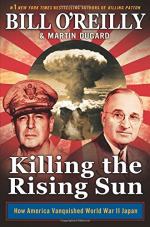|
This section contains 420 words (approx. 2 pages at 400 words per page) |

|
Killing the Rising Sun Summary & Study Guide Description
Killing the Rising Sun Summary & Study Guide includes comprehensive information and analysis to help you understand the book. This study guide contains the following sections:
This detailed literature summary also contains Topics for Discussion on Killing the Rising Sun by Bill O'Reilly.
Killing the Rising Sun by Bill O’Reilly and Martin Dugard is not just the story of how the Empire of Japan was defeated at the end of World War II, but why it required the atomic bombings of Hiroshima and Nagasaki to do it. Without glossing over the terror of the bombings themselves, the authors argue that the alternative to the A-bombs was an invasion of Japan that would have cost up to one million Americans their lives and possibly required a Soviet Russian presence in Japan. Instead, thanks to the bomb, the authors argue that America saved the lives of its own people, kept the communists out of Japan, and rebuilt its former enemy into an important ally.
O’Reilly and Dugard begin with the American and Japanese battles over territories the Japanese had occupied during their pre-war and wartime expansion. Though overmatched in numbers and arms, the Japanese nonetheless proved an extraordinarily difficult foe to overcome, willing as they were to fight to the death and commit unspeakable atrocities both military and civilian victims. In doing so, the authors establish both Japan’s responsibility for the outcome of the war, but also the horrifying alternative that an invasion might have represented, had the entire population embraced this willingness to fight to the bitter end.
As the Japanese empire receded and the invasion loomed, the book focuses on Harry Truman’s choices and the efforts of the mysterious J. Robert Oppenheimer, the scientist exerting his mind and body to develop the weapon that could end the war early. Despite setbacks and his own failing health, Oppenheimer successfully oversaw the testing of the first atomic weapon, which was then passed to the military in the Pacific for use. In the face of continued resistance by the Japanese the refusal of their government to surrender, the bombs were deployed on Hiroshima and Nagasaki, and the consequences too great for even a Japanese emperor who had convinced his people he was a god to ignore.
The book argues that the bombings, terrible as they may have been, ultimately saved many lives, including that of O’Reilly own father. It holds up Truman’s willingness to end the war through controversial decisions as an example to follow, while criticizing those who would have launched the invasion of Japan to further their own careers. It ends with the United States victorious, Japan rebuilding, and millions of young Americans grateful to have survived the most devastating war the world has ever seen.
Read more from the Study Guide
|
This section contains 420 words (approx. 2 pages at 400 words per page) |

|



